We recently tested a quartet of 9mm-chambered full-size firearms suitable for daily carry: the Lipsey’s Glock 17RTF2 Vickers FDE based on the Glock 17, a Beretta 92FS with Wilson Combat upgrades, an Arex Rex Zero 1 Standard, and a CZ-USA CZ P-10 C. Each one could be thrown into any mix of handguns and do well. But there are specific differences that will make one pistol or another preferable for an individual, and that is what this shoot out is all about.
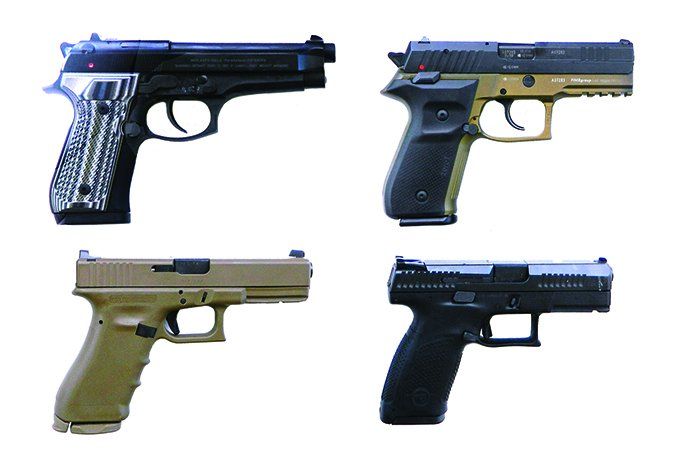
Full-size 9mm handguns have an impressive reserve of ammunition, they handle recoil well, and offer real power with +P loads. For home defense, a 14- to 18-shot 9mm handgun is effective, perhaps the best all-round home-defense handgun for a trained shooter. In this test, each pistol is an example of a popular carry gun as well, with many shooters concealing a Glock 17 or even a Beretta 92FS for daily carry. Here, all had faultless reliability, which is a prerequisite for a defense firearm in our testing. We also learned the Lipsey’s/Vickers Glock gave excellent results on the combat course, and the Wilson Combat-upgraded Beretta aced the field in accuracy. We trust these pistols, but only one was the best performer overall for our shooters. For certain preferences and duties, each has advantages, which we note in detail below.
Range Data
| Fiocchi Ammunition 147-gr. JHP | Beretta 92FS Wilson Combat | Arex Rex Zero 1 Standard FDE | CZ-USA CZ P-10 C | Lipsey’s Glock 17RTF2 Vickers FDE |
| Average velocity | 960 fps | 933 fps | 940 fps | 973 fps |
| Muzzle energy | 301 ft.-lbs. | 284 ft.-lbs. | 288 ft.-lbs. | 309 ft.-lbs. |
| Smallest group | 1.4 in. | 1.8 in. | 2.5 in. | 2.8 in. |
| Largest group | 2 in. | 2.2 in. | 3 in. | 3.5 in. |
| Average group size | 1.7 in. | 2 in. | 2.7 in. | 3.1 in. |
| Black Hills Ammunition 115-gr. +P JHP | ||||
| Average velocity | 1312 fps | 1280 fps | 1245 fps | 1299 fps |
| Muzzle energy | 439 ft.-lbs. | 418 ft.-lbs. | 396 ft.-lbs. | 431 ft.-lbs. |
| Smallest group | 1.7 in. | 2.2 in. | 2.3 in. | 3 in. |
| Largest group | 2.3 in. | 2.7 in. | 3.2 in. | 3.6 in. |
| Average group size | 2 in. | 2.5 in. | 2.7 in. | 3.3 in. |
| Precision Delta PDP Pro 124-gr. JHP | ||||
| Average velocity | 1090 fps | 1054 fps | 1066 fps | 1112 fps |
| Muzzle energy | 327 ft.-lbs. | 306 ft.-lbs. | 313 ft.-lbs. | 340 ft.-lbs. |
| Smallest group | 1.3 in. | 2.2 in. | 3 in. | 3.3 in. |
| Largest group | 2 in. | 2.7 in. | 3.4 in. | 3.8 in. |
| Average group size | 1.6 in. | 2.5 in. | 3.2 in. | 3.5 in. |
| Notes: Average velocity readings were recorded by firing five-shot strings over a Competition Electronics Pro Chrono. The muzzle was 10 feet from the first skyscreen. Ambient temperature: 85 degrees. Elevation: 815 feet above sea level. The accuracy figures are the average of three five-shot groups. For accuracy, we fired the test gun from a benchrest at a 25-yard target. Ammunition suppliers: Precision Delta PDP Pro 124-grain jacketed hollowpoint ($394.31/1000 rounds from PrecisionDelta.com); Black Hills Ammunition 115-grain jacketed hollowpoint +P ($15.10/20 rounds from VenturaMunitions.com); Fiocchi Ammunition 147-grain jacketed hollowpoint ($16.69/50 rounds from SportmansGuide.com). | ||||
All handguns tested for personal defense must be proven on the firing range. We tested two examples of upgraded service pistols. A special-run RTF texture Glock 17 from distributor Lipsey’s has a Vickers Tactical package added to it, with components suggested by or supplied by well-known trainer Larry Vickers. Likewise, we tested a Beretta 92FS updated with Wilson Combat parts. The results for both are better range performance, especially when performing rapid magazine changes because each package features a magazine guide and magazine base pads.
We matched the Glock and Beretta against the new CZ P-10 C, a polymer-frame striker-fired pistol, and the Arex Rex Zero 1 Standard, which is considered by some to be an improvement over the SIG P226 9mm handgun. We had a mix of two double-action-only polymer-frame striker-fired pistols, a double-action-first-shot pistol with a decocker, and a selective-double-action pistol with decocker.
In the end, the Glock’s highly advanced sights provided excellent results on the combat course. Perhaps the RTF frame was another plus. The Beretta 92 provided exceptional accuracy, which we felt was due to the improved trigger action. The CZ is an affordable and reliable handgun, and the Rex Zero is a good example of European craftsmanship. All in, it was hard to isolate a winner among these top-flight handguns with good performance. We think that most shooters will find the Glock 17 to be the best overall handgun for personal defense and home defense. Just the same, the CZ P-10 C is a good buy. Those seeking top-flight accuracy will find the Beretta to be a good fit. The Rex Zero has a quirk we did not like regarding reach to the magazine release, but the Arex is a good performer for some shooters, outperforming the Beretta in combat shooting. As usual, the devil is in the details, so here we go:
CZ-USA CZ P-10 C 91520 9mm Luger, $480
GUN TESTS GRADE: A- (BEST BUY)
Our local FFL had this new handgun and a used CZ P-10 C, one of the first, on hand. The backstory of the used gun was interesting. The former owner, a CZ fan, did not like the trigger. Elsewhere, the CZ P-10 C has good features, including well designed sights, a decent trigger action, and an ambidextrous slide lock and ambidextrous magazine catch. The pistol proved both reliable and controllable in rapid fire. For the shooter looking for a good defensive handgun at a fair price, consider the CZ P-10 C.
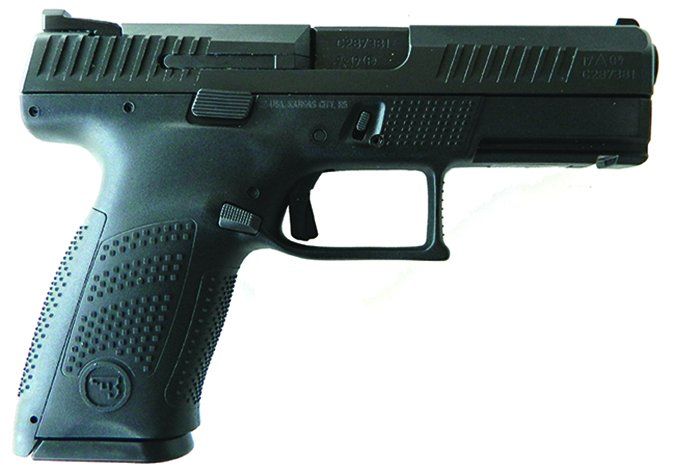
| ACTION | Double-action only; striker fire |
| OVERALL LENGTH | 7.3 in. |
| OVERALL HEIGHT | 5.25 in. |
| MAX WIDTH | 1.26 in. |
| WEIGHT UNLOADED | 26 oz. |
| WEIGHT LOADED | 30 oz. |
| BARREL | 4 in.; blued steel |
| MAGAZINE | 15-rd. detachable box |
| SLIDE | Steel |
| SLIDE-RACKING FORCE | 9.8 lbs. |
| FRAME | Fiber-reinforced polymer; interchangeable backstraps |
| FRAME FRONT STRAP HEIGHT | 2.5 in. |
| FRAME BACK STRAP HEIGHT | 3.6 in. |
| GRIPS | N/A |
| GRIP THICKNESS (max) | 1.2 in. |
| GRIP CIRCUMFERENCE (max) | 5.5 in. |
| FRONT SIGHT | Post, white dot |
| REAR SIGHT | Adjustable, two dots |
| TRIGGER PULL WEIGHT (SA) | 5.2 lbs. |
| TRIGGER SPAN | 2.7 in. |
| SAFETY | Firing pin block; trigger |
| WARRANTY | 5 years |
| WEBSITE | CZ-USA.com |
| TELEPHONE | (913) 321-1811 |
All of our prices reflect recent retail costs from online supplier SCGunCo.com. The P-10 C is CZ’s effort at a polymer-frame striker-fired handgun. The P-10 C is similar in size to the Glock 19. The slide is well finished in a deeply polished blue. The pistol features well-cut slide serrations and useful forward cocking serrations. The sights are well suited for either precision fire or for fast combat shooting. They feature the popular white three-dot-sight arrangement. The sight picture is well defined. The magazine release is ambidextrous, one of two pistols with this feature in the test. The slide lock is also ambidextrous. The pistol takes down using two levers in the Glock fashion. In common with the Glock, the trigger must be released for disassembly.
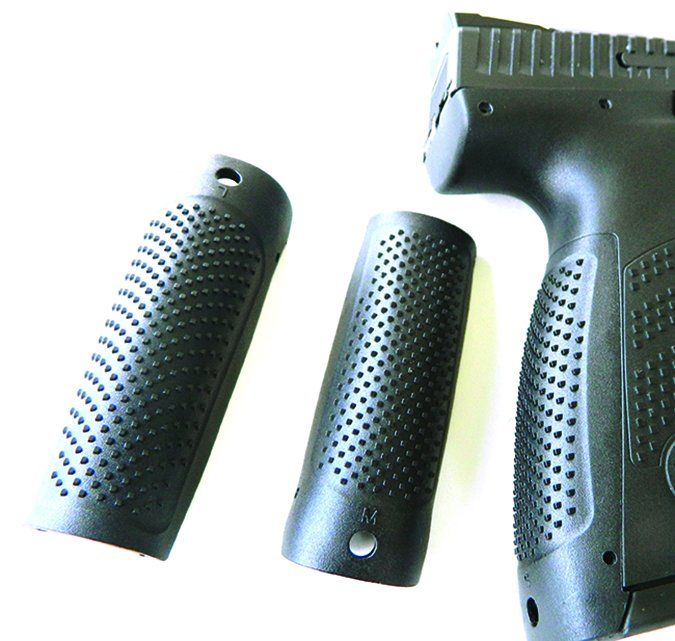
The pistol features a hooked trigger guard with a generous opening for gloved-hand use. The frame is roughened just above the trigger guard to allow positioning of the finger in a safe position. The frame is comfortable in the hand and well shaped, with a slight relief on each side that offers an advantage in trigger reach. There was some discussion concerning the frame treatment. The frame is a bit rough, with sharp pyramids on the surface. More workers use typewriters than jackhammers these days, and the frame proved uncomfortable for some shooters when firing +P loads. Just the same, the frame design offered excellent stickiness when firing. It compared well to the Glock RTF frame, which has also been criticized for excess roughness.
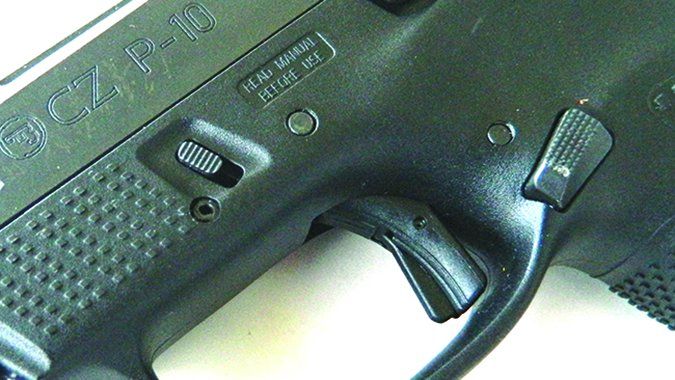
The magazine well is beveled to allow rapid magazine changes. There are dimples on each side of the lower frame at the magazine well that aid in grasping the magazine. The steel magazine holds 15 rounds. All of the controls are within easy reach of the fingers without shifting the grip, even for small to average size hands. The trigger action is similar to other polymer-frame striker-fired handguns. The slide partially preps the striker, and pressing the trigger then breaks the striker against the sear. Trigger compression is 5.2 pounds. Reset is sharp and rapid. We liked the heft and balance.
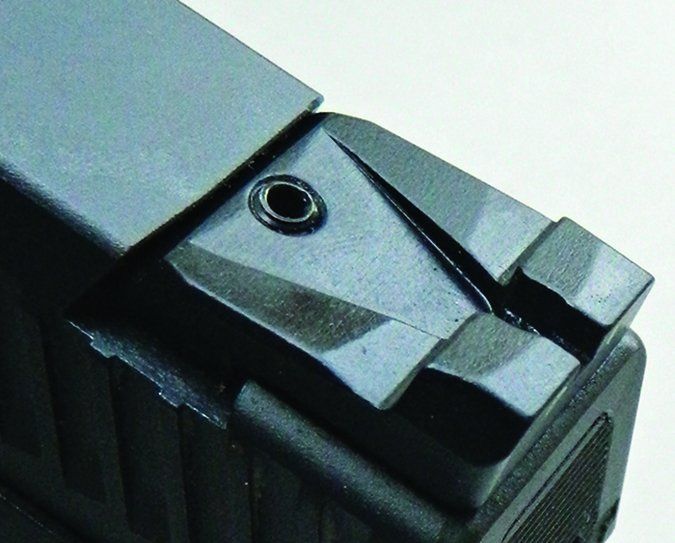
For the firing evaluation, we first loaded the magazines with the CCI Blazer 115-grain FMJ ($12.54/50 rounds at CheaperThanDirt.com). The magazines were loaded to a full 15 rounds. The CZ P-10 C is the most compact pistol tested and the lightest. Recoil was more noticeable than the other handguns, but not excessive. The low bore axis of the CZ allows the slide to ride low over the hand, providing less leverage to create muzzle flip than the aluminum-frame handguns. The striker-fired pistol is also fast into action with a rapid reset. As a result, the combat groups were good to excellent with this pistol. Only the Glock fared slightly better. Two concerns were raised. One rater mentioned he pressed the trigger and it would not budge. He has short fingers and did not properly press the safety lever in the face of the trigger. He did not make this misstep with the Glock. This was easily addressed by training and attention to detail. One of the female raters did not like the grip treatment, and one of the male raters noted the sharp edges became tiresome in a long firing test he had performed with a different CZ P-10 C. These are individual concerns that we pass along for your information. We shot the pistol for combat groups at 7, 10, and 15 yards, for a total of 150 rounds. We used the CCI Blazer 115-grain 9mm load in this combat test ($13.73/50 rounds at CheaperThanDirt.com). Control is good and so are fast follow-up shots. Only the Glock turned in a better showing, our testers said.
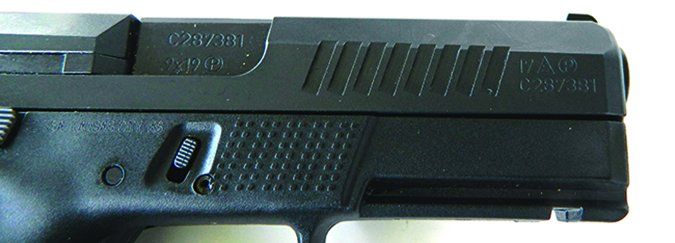
Fired for accuracy, we used the Fiocchi 147-grain JHP ($16.69/50 rounds from SportsmansGuide.com), Black Hills Ammunition’s 115-grain JHP +P ($15.10/20 rounds from VenturaMunitions.com), and the Precision Delta PDP Pro 124-grain JHP ($394.31/1000 rounds from PrecisionDelta.com) Firing from a solid bench rest, we produced five-shot groups for accuracy. The pistol was more accurate than the Glock 17 in this type of shooting, but it was not as accurate as either the Rex Zero or the Beretta. Still, this was the lightest handgun tested.
Our Team Said: In the end, there was much to like about the CZ’s performance. The pistol is reliable, light enough for constant carry, accurate enough for most uses, and exhibits good practical accuracy. The combination of features is attractive. The pistol’s frame treatment is uncomfortable for some users, but no more than the Glock rough-texture frame, most felt. Every handgun deserves attention to detail and the CZ will reward a trained shooter with good performance. Because of its price, it earned a Best Buy tag in addition to its high grade.
Lipsey’s Glock 17RTF2 Vickers FDE 9mm Luger, $630
GUN TESTS GRADE: A- (Our Pick)
This is as nice a Glock as we have handled. The pistol demonstrates the typical Glock 9mm reliability and handles much like any other Glock 17. The FDE finish is a nice touch. The advantages include the Vickers Tactical sights, which made this gun our top combat choice. The magazine guide and base pads added to the pistol’s fast handling.
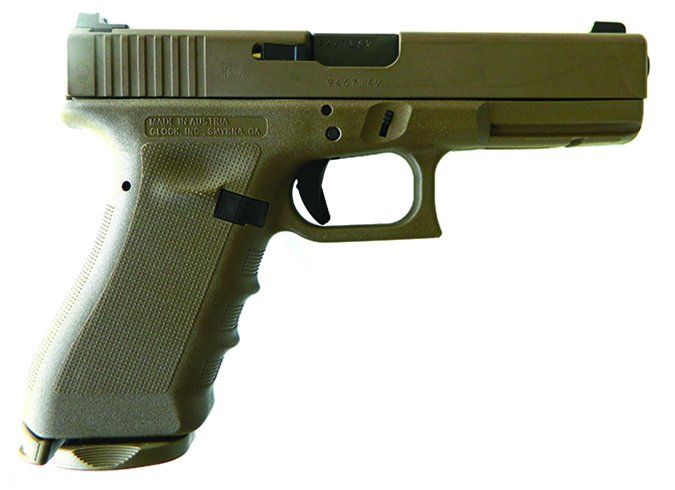
| ACTION | Safe Action, Glock 17 Series |
| OVERALL LENGTH | 8.03 in. |
| OVERALL HEIGHT | 5.1 in. |
| MAX WIDTH | 1.4 in. |
| WEIGHT UNLOADED | 25 oz. |
| WEIGHT LOADED | 32.2 oz. |
| BARREL LENGTH | 4.48 in. |
| BARREL | Steel |
| MAGAZINE | (2) 17-rd. detachable box |
| SLIDE | Steel; Flat Dark Earth Cerakote finish |
| FRAME | Glock RTF2 polymer; Flat Dark Earth Cerakote finish |
| FRAME FRONT STRAP HEIGHT | 2.5 in. |
| FRAME BACK STRAP HEIGHT | 3.5 in. |
| GRIPS | N/A |
| GRIP THICKNESS (max) | 1.2 in. |
| GRIP CIRCUMFERENCE (max) | 6.2 in. |
| FRONT SIGHT | Wilson Combat Vickers Elite Battle; green tritium AmeriGlo post |
| REAR SIGHT | Wilson Combat Vickers Elite Battle; U-notch rear |
| TRIGGER PULL WEIGHT | 5.5 lbs. |
| TRIGGER SPAN (SA) | 2.7 in. |
| SAFETY | None |
| SLIDE-RACKING FORCE | 10.6 lbs. |
| WARRANTY | 1 year |
| WEBSITE | Lipseys.com (FFLs only) |
| TELEPHONE | (225) 755-1333 |
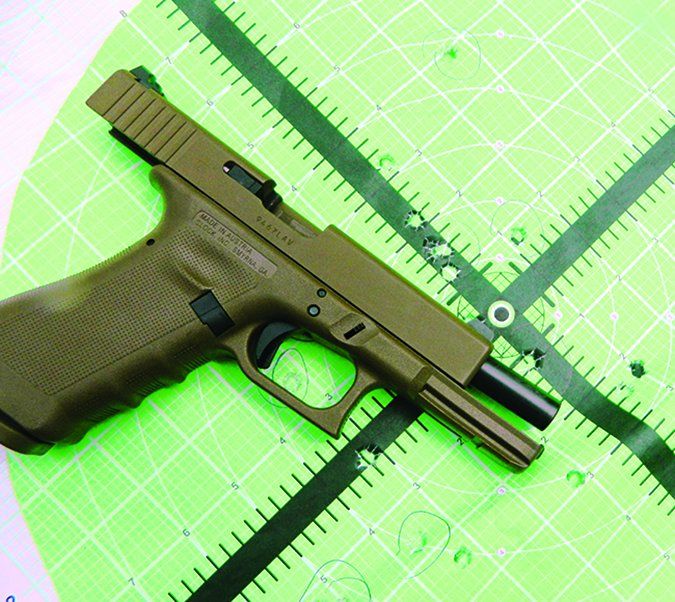
This was our price from SCGunCo.com. This is a special-order run from Lipsey’s, a major firearms distributor, which began selling the Vickers-enhanced pistols in 2015. This pistol is a Flat Dark Earth (FDE) version of the Glock 17 with custom additions from trainer Larry Vickers. The fit and finish are standard Glock, very consistent and well put together. While the rough texture frame (RTF) has been discontinued in standard production, it is carried on in the Vickers Tactical Glock 17. The trigger breaks at 5.5 pounds, 0.3 pound heavier than the CZ. The grip frame is the discontinued Rough Texture Frame that is rejuvenated in this custom line. It fits the hands well, and the frame offers superior adhesion in rapid-fire strings. The pistol features a magazine well and custom basepads. This enhances rapid magazine changes and ammunition replenishment. The modification doesn’t cause any problem when using stock magazines.
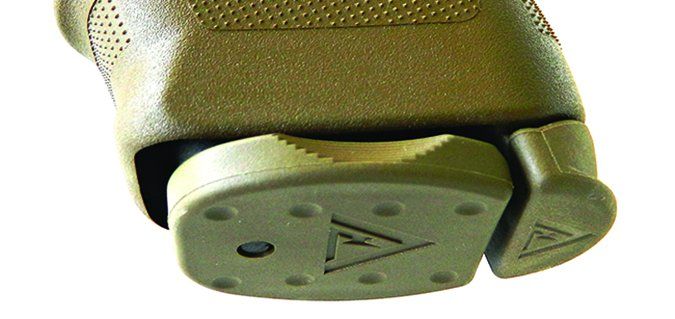
While the RTF frame and the Vickers magazine well are good to have, the primary advantages in the Vickers Tactical Glock compared to the standard Glock 17 are the sights. The Vickers sights are a special U-notch rear and tritium-dot front. The rear sight is nicely serrated on the rear face to cut down on glare, and the front sight offers a bright, round, green aiming point. These sights proved to be a great advantage during combat shooting, and they would be the best choice for personal defense, we all felt. The slide lock and magazine catch are not ambidextrous, so that’s an issue for lefties. The pistol is well balanced and fits the hand well. The pistol was supplied with an extended magazine release and slide lock in the box, but we did not use these because the gun was well set up as it was.
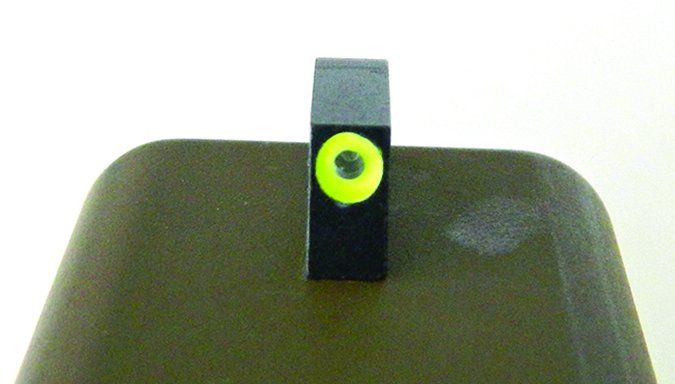
In firing tests, we began with the Blazer 9mm ammo and found the Glock provided the best results of any of the handguns tested regarding rapid sight acquisition and combat firing. In combat drills, the weight of the Glock provided a better platform for recoil control, and the pistol fared better in combat shooting than the CZ P-10 C, we believe. The Glock also beat the other handguns in combat drills, in particular the rapid trigger reset and easy control. Conversely, in benchrest accuracy, the Glock was the least accurate handgun tested. Using every advantage and using the Bullshooters pistol rest in the final set, the Glock was acceptably accurate, but that is all. Just the same, the pistol was accurate enough for defense use. The sights, intended for fast hits at combat range, played against us in precision fire.
Our Team Said: We rated the Glock down a grade on accuracy and frame roughness because some of the raters did not like the grip texturing. If price is not a consideration, then this pistol is Our Pick for defense use in this test.
Beretta 92FS w/ Wilson Combat Upgrades 9mm Luger, $550 used
GUN TESTS GRADE: B
The Beretta is smooth, well finished, and the most accurate handgun tested. Energy and velocity are also the highest. The double-action first-shot trigger was the smoothest Beretta we have tested and among the best double-action triggers ever tested, due to the addition of Wilson Combat springs. A grip circumference of over 6 inches did not fit all shooters well. The grip and high bore axis worked against the pistol in combat shooting.
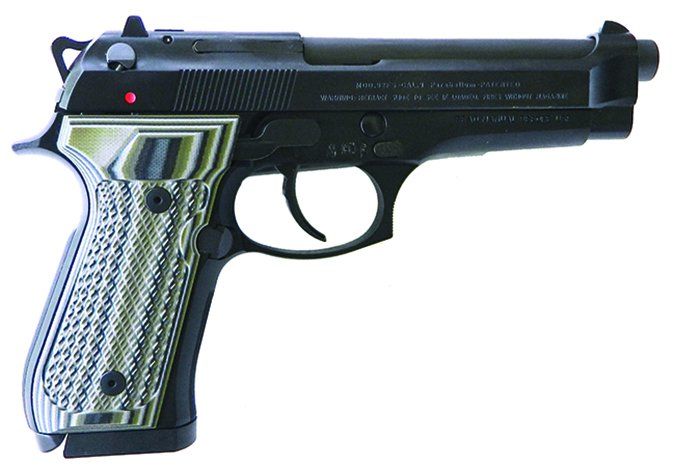
| ACTION | Double action first shot; open-slide, short recoil delayed locking-block system |
| OVERALL LENGTH | 8.5 in. |
| OVERALL HEIGHT | 5.5 in. |
| MAX WIDTH | 1.5 in. |
| WEIGHT UNLOADED | 34 oz. |
| WEIGHT LOADED | 40 oz. |
| BARREL LENGTH | 4.9 in.; Bruniton-finished steel |
| MAGAZINE | 15/17-rd. detachable box; reversible magazine release |
| SLIDE | Bruniton-finished steel; open top |
| FRAME | Anodized aluminum alloy |
| FRAME FRONT STRAP HEIGHT | 2.2 in. |
| FRAME BACK STRAP HEIGHT | 3.2 in. |
| GRIPS | G10VZ Grip |
| GRIP THICKNESS (max) | 1.4 in. |
| GRIP CIRCUMFERENCE (max) | 6.1 in. |
| SIGHTS | Fixed |
| TRIGGER PULL WEIGHT (DA) | 9 lbs. |
| TRIGGER PULL WEIGHT (SA) | 4 lbs. |
| TRIGGER SPAN (SA) | 2.6 in. |
| SAFETY | Decocker |
| SLIDE-RACKING FORCE | 8.5 lbs. |
| WARRANTY | None |
| WEBSITE | Beretta.com |
| TELEPHONE | (800) Beretta |
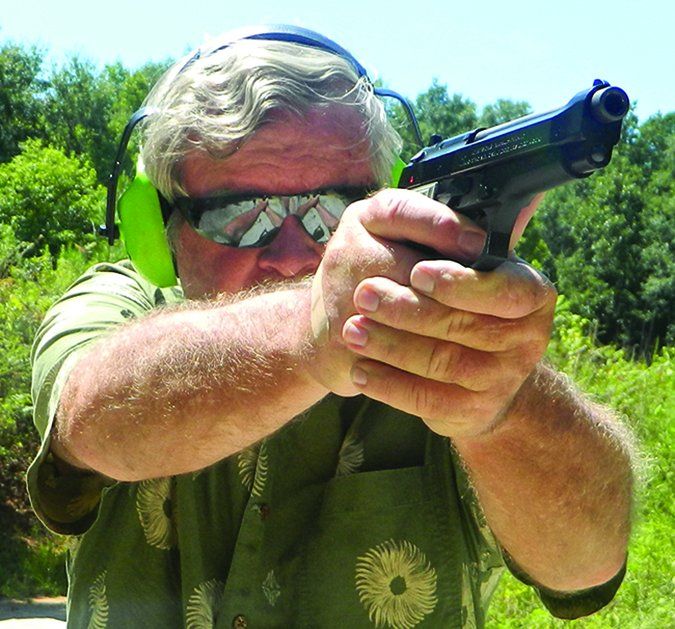
We bought this gun used from SCGunCo.com for the price shown. This Beretta isn’t to be confused with the Beretta Brigadier-type handgun offered by Wilson Combat. This isn’t a Wilson Combat pistol, but is instead a 92FS that was upgraded by an unknown previous owner with judicious choices of Wilson Combat parts. We attempted to value the parts package by pricing the components at Brownells.com. Those parts included Wilson Combat upgrades, as follows: Wilson Combat action springs tune kit, $14.95; Wilson Combat safety low profile, single, $41.95; Wilson Combat magazine release, $41.95; Wilson Combat magazine guide $49.95; and a VZ Grip, $75. That’s a total of $223.80 in upgrades, and the pistol came with one 15-round and two 17-round MecGar magazines, making this Beretta a very good buy.
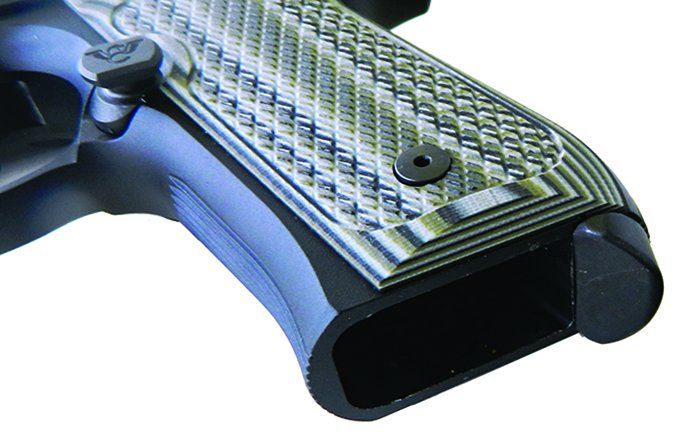
The Beretta 92 is well finished, with a nice blue metal tone. There were no tool marks. The sights are three-dot types with good visibility in most situations. The traditional open-top slide is a Beretta trademark. While touted for reliability, lightening the slide confers other advantages in a gun this size, such as gross weight reduction.
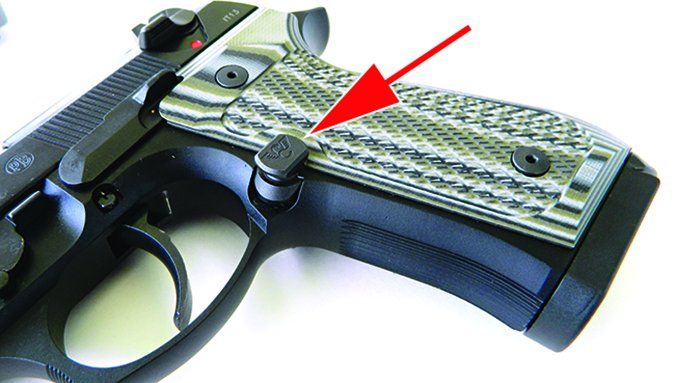
The Beretta takedown is easier than the Glock. The Beretta has a higher bore axis than the Glock or the CZ pistol, and this was a factor in combat shooting. The Beretta features a combination safety/decocker. If a manual safety is important to you, then this pistol and the Rex Zero are contenders. However, you give up an ambidextrous safety by adding the Wilson Combat safety. Some like the look of the pistol better without the ambi safety. The Beretta is a large handgun, and hand fit is an issue, but the raters managed to do good work with it anyway. The pistol’s trigger action was very nice, a result of careful tuning perhaps, or simply dropping in the Wilson Combat spring kit. The trigger breaks at 9 pounds in double-action mode and a smooth and crisp 4 pounds in the single action. The VZ grips aided in adhesion without causing abrasion. The extended magazine well was an aid in rapidly changing magazines without a misstep. We rated the Glock and the Beretta even in this regard and really liked the addition. Coupled with the Wilson Combat speed magazine latch, the pistol was very fast and smooth to operate.
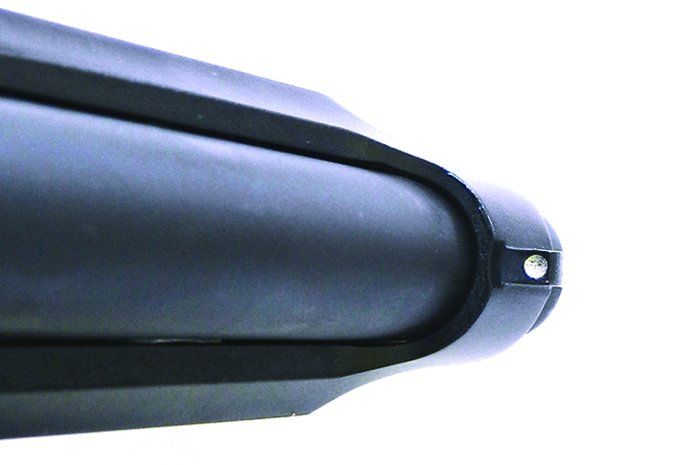
The Beretta is easy to control, with little muzzle flip. It was the most comfortable pistol to fire with all loads. The Beretta is also the heaviest gun tested, and this weight also limits muzzle flip. In the combat-firing test, the Beretta turned in credible results, but it was behind the other three pistols when firing for maximum speed. We fired using the double-action trigger at 7 yards to begin the test. Results were better than the Rex Zero and behind the polymer-frame handguns. Moving to 10 and 15 yards, we found the Rex Zero turned in tighter combat groups. However, firing the three accuracy loads from the benchrest was a surprise. The Beretta turned in excellent groups. The smallest groups were just over an inch and a half. One of the raters summed it up: “If I were in a fight with a takeover gang, the Glock is the best choice. I can get hits on multiple targets quickly. If a shooter is behind cover at 20 yards and the only target is tiny, the Beretta gives me an advantage.” The Beretta is clearly a very accurate handgun.
Our Team Said: The Beretta was rated an A initially; however, brainstorming addressed practical considerations, and its less competitive combat-shooting ability compared to the higher-ranked guns had to be accounted for. The pistol also doesn’t have a provision for a light rail. As purchased, this is a good buy, and the pistol is certain to fill a real need for someone.
Arex Rex Zero 1 Standard FDE 9mm Luger, $634
GUN TESTS GRADE: B
Fit, finish, and an absence of internal tool marks told us that the pistol is built to high European standards. The sights are good; we like the forward cocking serrations, the ambi safety, and the easy takedown. We believe the dual-function slide lock and decocker is an improvement over the SIG P series the pistol is modeled after. The double-action trigger was also heavier than we liked.
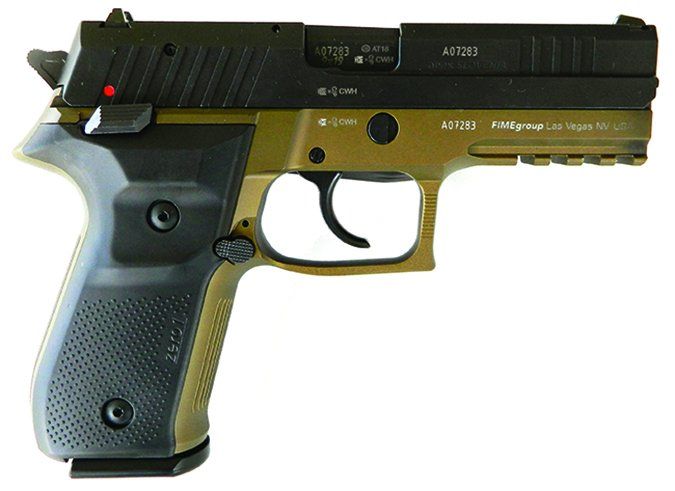
| ACTION | Double-action first shot; modified Browning short recoil |
| OVERALL LENGTH | 7.7 in. |
| OVERALL HEIGHT | 5.7 in. |
| MAX WIDTH | 1.35 in. |
| WEIGHT UNLOADED | 29 oz. |
| WEIGHT LOADED | 35 oz. |
| BARREL | 4.25 in.; chrome-moly steel; loaded chamber indicator; nitro-carburized finish |
| MAGAZINE | 17-rd. detachable box |
| SLIDE | Chrome-moly steel; nitro-carburized finish |
| FRAME | 7075 aluminum alloy, hard anodized finish; MIL-STD 1913 accessory rail |
| FRAME FRONT STRAP HEIGHT | 2.8 in. |
| FRAME BACK STRAP HEIGHT | 3.6 in. |
| GRIPS | Plastic |
| GRIP THICKNESS (max) | 1.3 in. |
| GRIP CIRCUMFERENCE (max) | 5.8 in. |
| SIGHTS | Fixed |
| TRIGGER PULL WEIGHT (DA) | 12.5 lbs. |
| TRIGGER PULL WEIGHT (SA) | 4.2 lbs. |
| TRIGGER SPAN (SA) | 2.65 in. |
| SAFETY | Firing pin catch |
| SLIDE-RACKING FORCE | 10.2 lbs. |
| WARRANTY | Lifetime |
| WEBSITE | FIMEGroup.com |
| TELEPHONE | (702) 215-3600 |
The Arex Rex Zero 1 Standard is a service-size 9mm handgun that bears a great deal of resemblance to the SIG P226R. The company that manufactures the Rex Zero is located in Slovenia and has a reputation for producing military-grade gear. The Rex Zero is a conventional locked-breech handgun that butts the barrel hood into the ejection port for lock up and uses an angled locking wedge for unlocking. The pistol is a double-action-first-shot handgun. The handgun type with a manual safety to complement the decocker is often referred to as a selective double action. The Rex Zero transfers energy to the hammer by means of an internal drawbar versus the Beretta’s Walther P38-derived drawbar located on the right side of the frame. The double-action first shot is heavy at about 15 pounds versus 9 pounds for the Beretta. The single-action trigger is light enough at 4.25 pounds with the typical slower reset of the SIG-type pistols. The slide is well machined, with useful forward cocking serrations. The sights are good service-grade units with three-dot white inserts. We found the sights were well designed and well regulated for 124-grain loads. The hammer and trigger are conventional designs. We liked the wide, smooth trigger face.
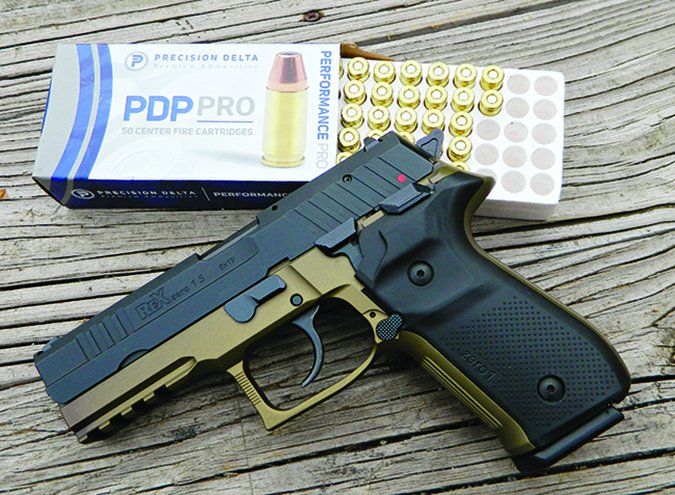
The grips are indented for better trigger reach. The pistol is more comfortable for most hand sizes than the Beretta 92, despite a similar circumference. The primary difference in the pistol’s layout and the SIG P226 is in the controls. The magazine release is ambidextrous. Some of the raters were unable to actuate the magazine release from the firing position using the firing-hand thumb. All were able to hit the release properly using the firing-hand trigger finger; others had to shift the grip to reach the magazine release. So, it can be done, but only by using a different manual of arms. The forefinger activation is the preferred drill and is superior, we believe, to shifting the grip.
In the other controls we find improvements to the SIG P Series. The most interesting is the combination slide lock and decocker. The SIG, it has been noted, is subject to the student riding his thumb on the slide lock, and as a result, the pistol does not lock open on the last shot. With the Arex design, there is no slide lock on the upper frame in SIG fashion. The decocker is also the slide lock. With the slide locked to the rear, the decocker lever is pressed to lower the slide. Another press decocks the hammer. We used the lever quite a lot and attempted to produce a malfunction, such as dropping the slide and the hammer simultaneously, but were unable to do so. The combination lever is a viable improvement and works as designed.
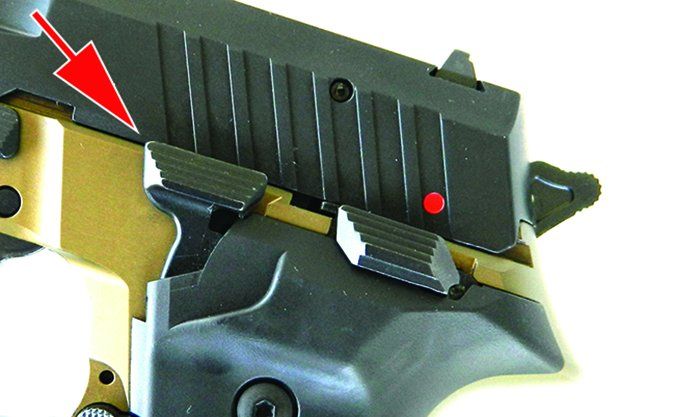
The Rex Zero also incorporates a safety into the design. Located in the spot that normally is occupied by a slide lock, this safety allows carrying the pistol hammer to the rear and safety on or hammer down and safety on. You may choose not to engage the safety as well. It isn’t cocked and locked carry by definition, as the slide isn’t locked by the safety. We feel the value of this safety is in tactical movement. When you have fired and then you are moving, you would have to decock a conventional Beretta or SIG-type pistol to make it safe. Not so with the Rex Zero (and the CZ-75 among a few others). Simply apply the safety, and then take the safety off when you are ready to fire.
The test pistol was supplied in a flat dark earth finish. There is a rail for mounting combat lights, a big plus over the Beretta and an equal feature found on the polymer-frame handguns. The frame serrations and grip treatment allow for adequate abrasion and adhesion when firing. The pistol is supplied with two magazines.
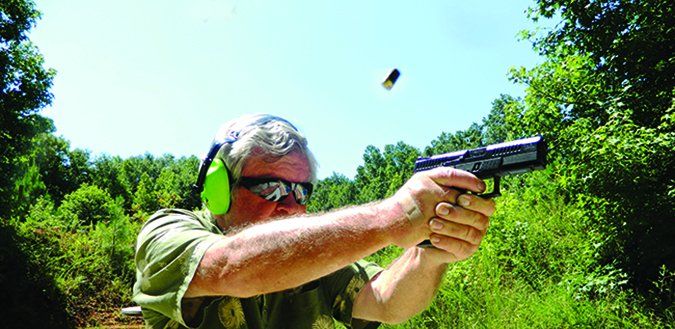
During the range drills, we used the Blazer 115-grain FMJ loads. The pistol was drawn and fired at combat ranges. The long and heavy double-action trigger allowed a straight-through trigger press, but it was harder to manage than the Beretta. The Rex Zero suffered in making first-shot hits compared to the Beretta. However, in the single-action mode, the heft, balance, hand fit, and control were superior to the Beretta. The difference was such that the Rex Zero gave a better showing, overall, than the Beretta. In benchrest fire, the single-action trigger was controllable and the sights were clean and crisp, leading to the Arex being more accurate than the Glock or the CZ P-10 C. The Beretta, however, was considerably more accurate with all loads.
Our Team Said: Once we mastered the reloading technique necessary to change magazines quickly, the Rex Zero was a capable combat pistol. We rated the pistol down a half grade based on the need to adopt a non-conventional manual of arms for reloading and another half grade based on the heavy double-action trigger.
Written and photographed by Gun Tests staff.




























